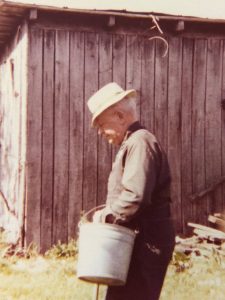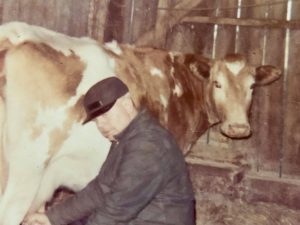 Driving down Shadden Road in Gray, Tennessee, will bring you by a neighborhood development called “Cargille’s Crossing.” The sign there depicts a silhouette of a man wearing a hat, carrying a cane and what appears to be a bucket. That’s my Granddaddy, and much of the surrounding land used to be his farm.
Driving down Shadden Road in Gray, Tennessee, will bring you by a neighborhood development called “Cargille’s Crossing.” The sign there depicts a silhouette of a man wearing a hat, carrying a cane and what appears to be a bucket. That’s my Granddaddy, and much of the surrounding land used to be his farm.
Born in 1907, Cargille Hale, my Granddaddy, was quite a character, and I ran out of time and space when I wrote about him a few weeks ago. I couldn’t quite fit everything I wanted to share about him into one article. To me, he was a loving grandfather who enjoyed a quiet life on his farm—and that is how I remember him.
Granddaddy, my mother’s father, walked with a wooden cane, the kind that curves at the top. I’m not sure when he started walking with a cane or what necessitated the assistance, but he used a cane as long as I can remember. He was somewhat of a bee charmer—he had hives on the farm and could reach into them to pull out honey, his hand and arm covered with bees, and not get stung. He chewed Beech-Nut Chewing Tobacco, which he would buy by the carton. He liked to eat puffed wheat—a food that, despite its blandness, his four grandchildren enjoy to this day with nostalgia. He drank Alka-Seltzer every day, and used to let us grandkids “plop, plop” the little tablets into his glass of water to see and to hear the “fizz, fizz.” He liked peanuts in his bottle of Coke and salt on his watermelon. The Japanese beetle was his archnemesis.
After a long day of work on the farm, he would sit on the front porch or in the front yard for a spell and watch the world go by. He’d put us kids on his knee, bouncing us up and down as we played “riding horsey.” From time to time, he’d let us ride on the tractor with him, giving us a turn at the wheel. He kept time with a pocket watch, which he would pull out of his Pointer Brand overalls and check throughout the day.
 I was hesitant to share this because it might sound quite odd, but Granddaddy had another trait that was rather interesting—and perhaps even a little questionable. He was able to remove warts for people—and he didn’t need a blade or a flame or even liquid nitrogen to do so. As my mother put it when I asked her about it several years ago: “He would rub them some way and say something silently, and they would go away. I never did have one for him to take off, but I know he did it for other people.”
I was hesitant to share this because it might sound quite odd, but Granddaddy had another trait that was rather interesting—and perhaps even a little questionable. He was able to remove warts for people—and he didn’t need a blade or a flame or even liquid nitrogen to do so. As my mother put it when I asked her about it several years ago: “He would rub them some way and say something silently, and they would go away. I never did have one for him to take off, but I know he did it for other people.”
Now, I have to admit, this always intrigued me and today even seems like some sort of sorcery or something strange, but some Internet sleuthing revealed that this kind of wart removal was not uncommon in Appalachia. My sister Robin, who shared a special bond with Granddaddy, remembers that he told her that he planned to share with her the secret to this wart-removal process—but that after he told her, he then would no longer be able to do it. As it turned out, the passing on of the secret didn’t happen before Granddaddy passed away, and I suppose he took it to his grave.
At some point around the early or mid-1980s, my sister Cindy interviewed Granddaddy for a school project. During the interview, he said that the best U.S. president was Hoover, but that Kennedy and Roosevelt were good, too. When he was growing up, his closest neighbors were almost a mile away. His family didn’t have electricity, so they used kerosene lamps—and they had an outhouse, too. If they wanted to use a telephone, then they had to go to town. His first car was a Model T, for which he paid about $350. When he first started working, he earned 10 cents an hour on the farm and 28 cents an hour when he started at Eastman.
For your reading pleasure, here are a few more questions and answers from the interview:
Q: What are some of the most drastic changes that you have seen in your lifetime?
A: The most drastic change would have to be from the horse and buggy as the main means of transportation to the automobile. Other changes would be with television and radio. Computers have changed a lot of things. All of the trips into space would be another big change.
Q: What was school like when you were growing up?
A: I had to walk about four miles to school every day—even in rain, snow, sleet or hail. We didn’t have so many different classes like they do today. We just had basic arithmetic, writing and reading.
Q: What did you do for entertainment before television came along?
A: We listened to other people sing or play their musical instruments. We had our phonographs and radios that we listened to. We also played games and sports, such as basketball and baseball.
Q: What kind of music did you listen to when you were in your teens?
A: We listened to a lot of different kinds—very different from the kinds of music that teen-agers listen to today. We had country, classical and some gospel. We usually listened on our phonographs or on the radio, and sometimes at church or at dances.
Q: What kind of social life did teenagers have in those days? How was it different from today?
A: It was very different! We didn’t get to go to town very much, like kids do nowadays. When we did get to go, we had to ride the train, ride a mule or walk to where we were going.



